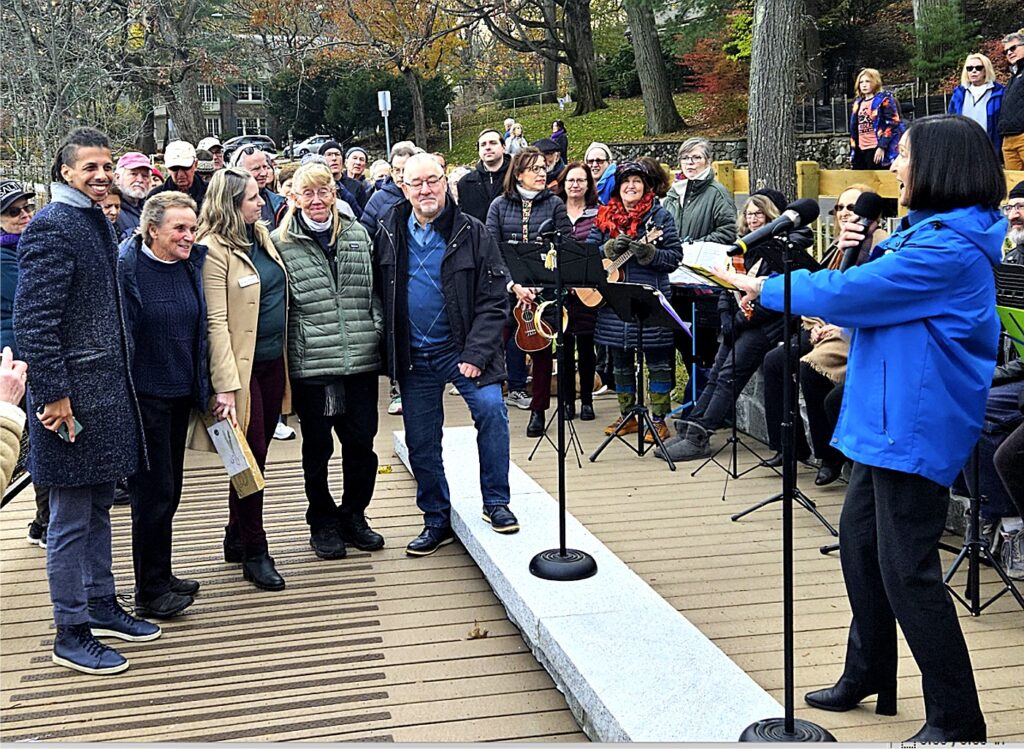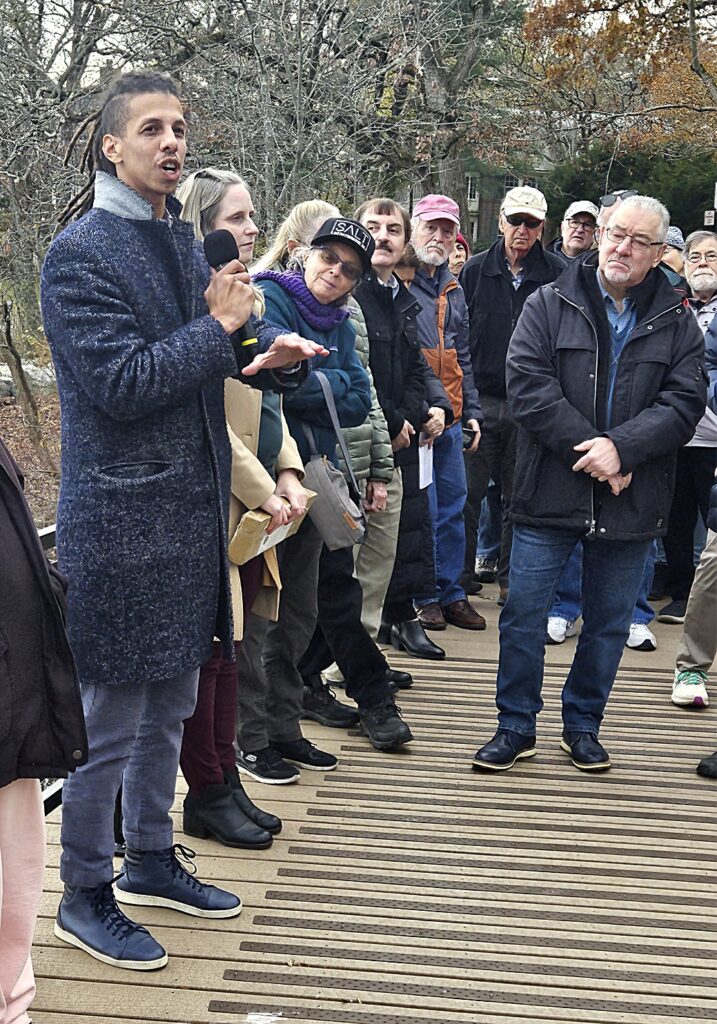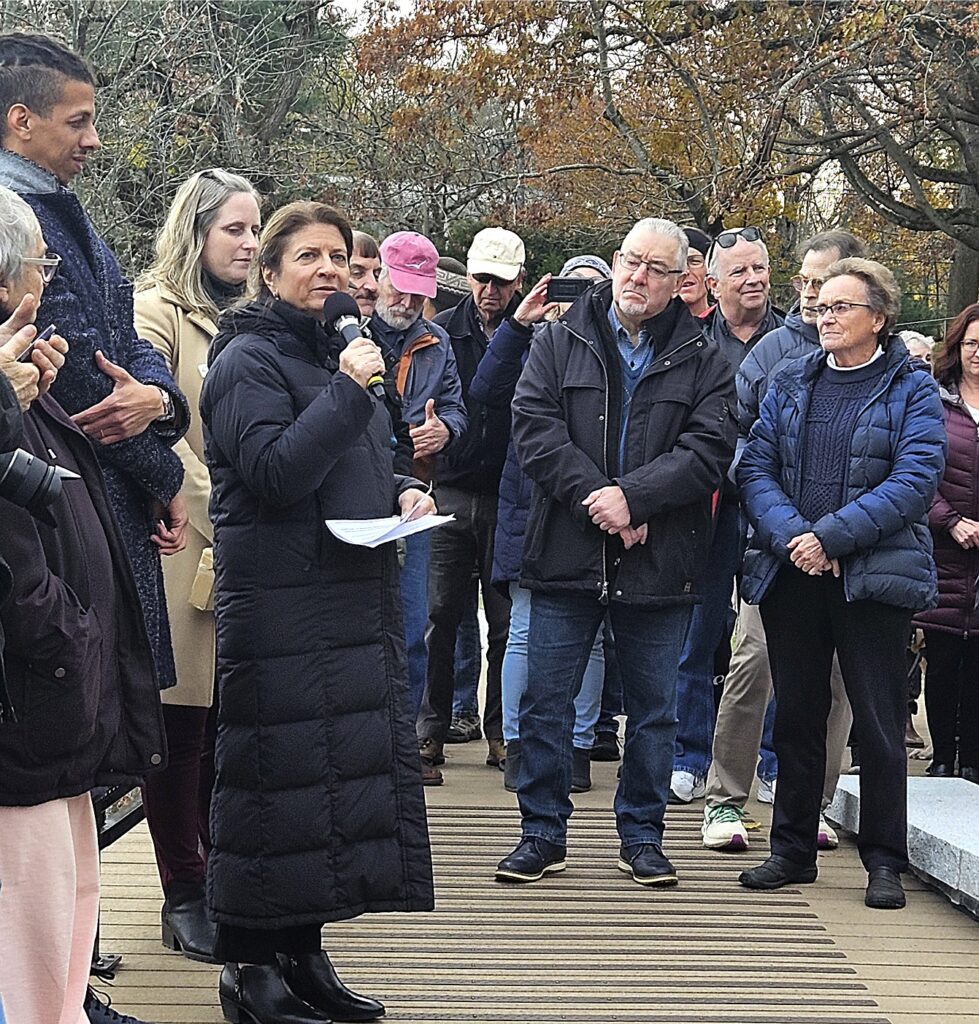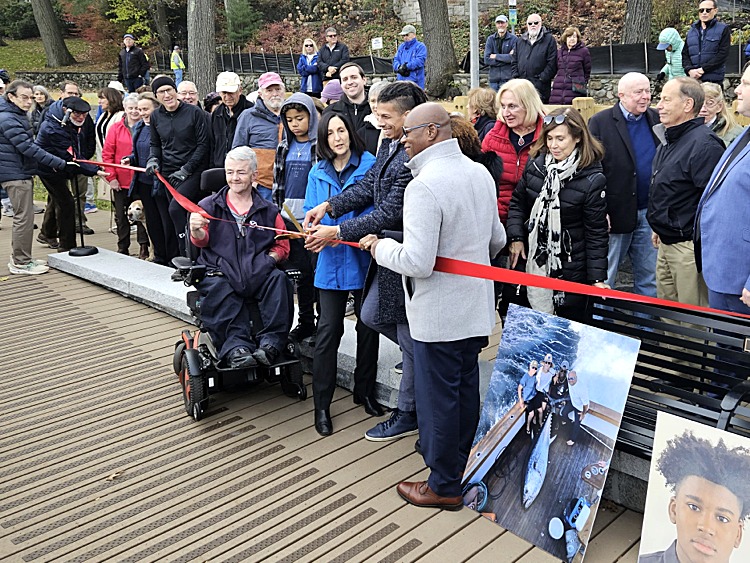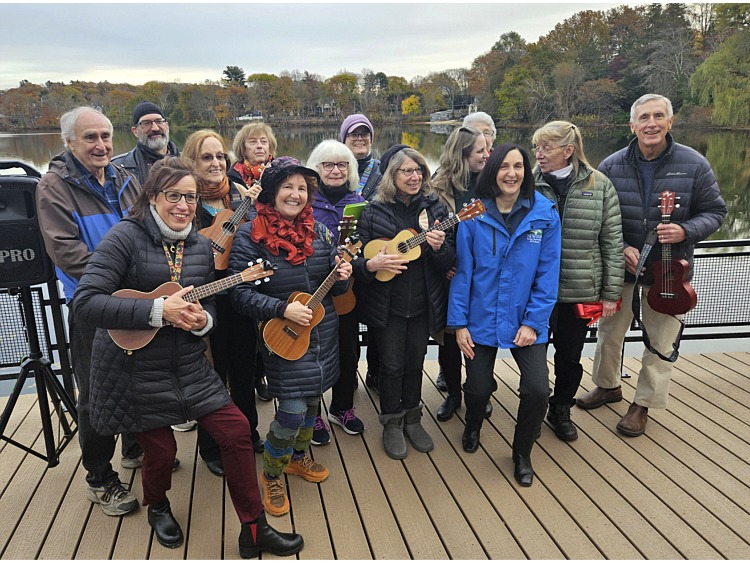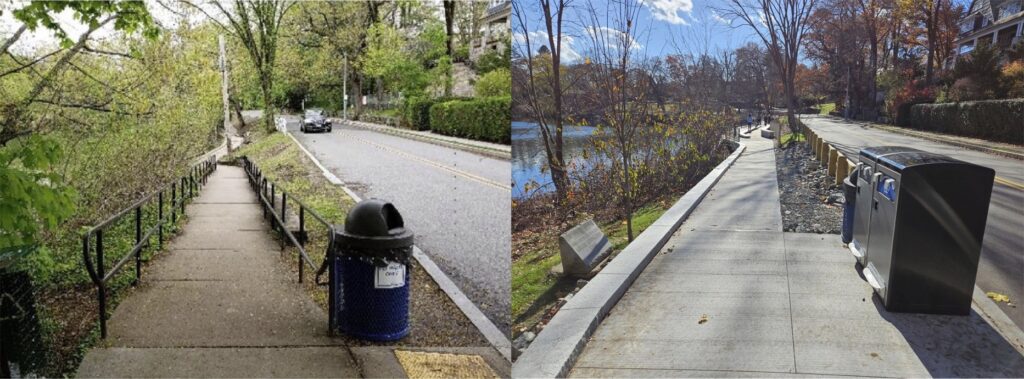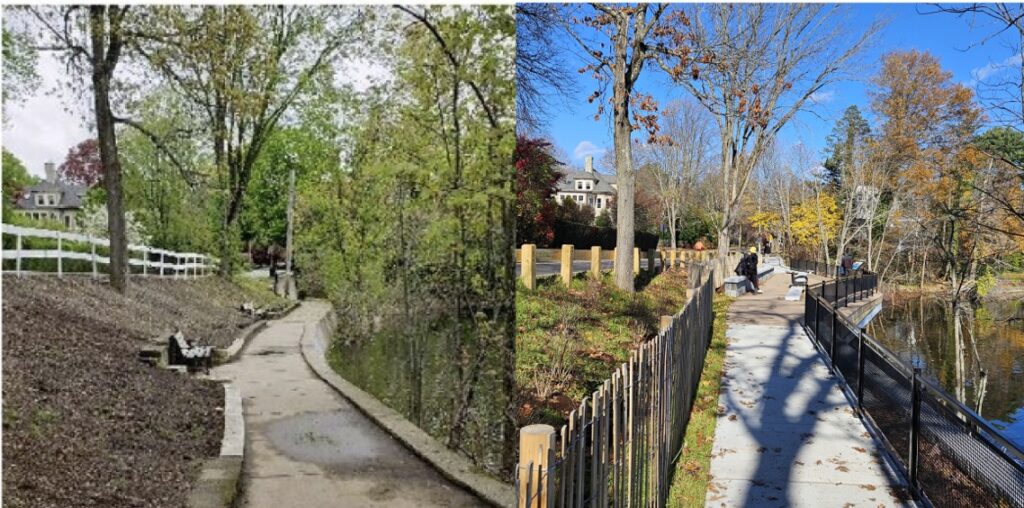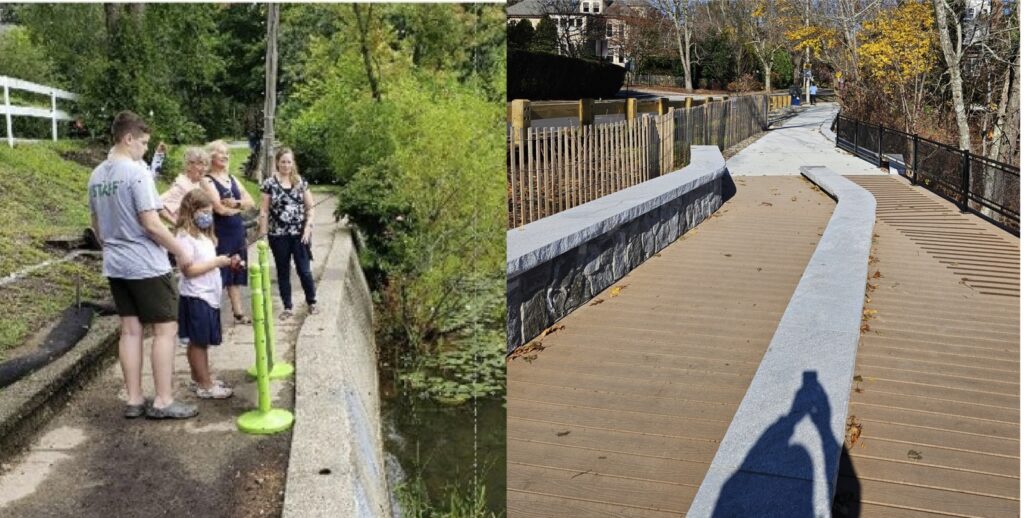On a sunny, sparkling November 15th, about 100 residents joined city officials along the Lake Avenue shore of Crystal Lake for a ribbon cutting to celebrate the long-awaited completion of the Levingston Cove Improvements project. According to the Parks, Recreation and Culture Department, Levingston Cove’s redesign will make the park more accessible for people of all levels of mobility, for fishing and for enjoying the lake. In addition to changes in recreational options, the project will improve control of erosion and stormwater infiltration into the lake, and reintroduce native vegetation for wildlife habitat.
Among the Cove’s new features is a new platform on two levels, cantilevered over the lake to add about 500 square feet to the park for pedestrians and fishermen. Construction and suspension of the platform required many truckloads of concrete and the drilling of about 40 micropiles in the shoreline to avoid drilling or construction in the lakebed, to protect water quality. A new stone stairway from Lake Avenue to the shoreline is designed to guide pedestrian traffic around areas that have been restored from dirt to grass. The project was originally expected to be completed by mid-June and then mid-July but was held up by delays in delivery of railings that line the platform and stairway.
Heralding the ribbon-cutting event, the City Hall Strummers — about a dozen local ukulele players led by Newton’s Director of Cultural Development, Paula Gannon — played and sang, inviting the crowd to join in.
In her remarks, Mayor Ruthanne Fuller thanked current and former City staff – in particular, former Parks & Recreation Commissioners Bob DeRubeis and Fran Towle, current Commissioner Nicole Banks, former manager Carol Stapleton, current Director of Parks + Open Space Luiz Perez Demorizi, Chief Environmental Planner Jennifer Steel, and ADA Coordinator Jini Fairley. And she recognized the many community volunteers and groups supporting the project, including Crystal Lake Conservancy, Newton Conservators, Friends of Crystal Lake, and neighboring residents.
Highlighting new design aspects, the Mayor noted the “ingenious [and] hidden,” erosion-control walls that double as seating areas. The project cost $1.6 million, of which $1.4 million was from Community Preservation Act funds.
Over time, State Representative Ruth Balser, a devoted supporter of Crystal Lake, has been instrumental in appropriating more than $360,000, in state funding, a portion of which was used for technical support for the project. Mayor Fuller acknowledged Rep. Balser’s ongoing support.
Opponents of the Levingston Cove construction had placed “Remove the Boulders” and “No Boulders” signs along Lake Avenue, which the Mayor acknowledged, noting that Newton is a place where people have different opinions. She said “Thank you for sticking with us and raising your voices, and I hope we got it largely right. I think we did.” Director of Parks and Open Space Luis Perez Demorizi thanked people for “keeping the design team on their toes, making sure [the project] could be the best that it could be.” He said that Levingston Cove was part of what he called “the Crystal Lake renaissance.”
In a solemn moment, the Mayor invited Darryl Settles and Lisa Owens to come forward to the memorial bench they had donated in memory of their teenage son, Preston, who died last year. Preston was a Crystal Lake enthusiast.
Janice Bourque, co-president of the Crystal Lake Conservancy (CLC), spoke about ten years of testing water quality for phosphorus, nitrates, and bacteria – and how the project’s rain gardens, terracing, and vegetation are designed to mitigate these problems. In a later discussion with Fig City News, Ms. Bourque explained that the lake is not spring-fed, but exists because of rainfall runoff, and that because of soil erosion and elements in the runoff, the lake is susceptible to the growth of algae, which produces harmful cyanobacteria. New storm drains, rain gardens, and improved terracing were installed as part of the Levingston Cove project to help reduce the runoff of unwanted materials into the lake.
Earlier, Ms. Bourque and the CLC opposed the placement of the boulders and sharp rocks along the shoreline, inhibiting easy access to the water. “We were surprised by the boulders that were not supposed to be placed that way.” She and others have said the original design did not show the boulders with rocks in between. The CLC “would have liked to be part of the decision-making, but the City made up its mind,” she said. Moreover, Ms. Bourque feels there needs to be a comprehensive master plan rather than a piecemeal project approach to Crystal Lake.”
Since the park’s opening, residents have expressed a range of opinions. Masha Sand, a local resident, who walks along the Lake nearly every day, said it’s “over engineered” and has lost its natural “rustic” look. A mother of two, Ms Sand also lamented the price of the project at a time when the schools are struggling to provide teachers and programs.
Srdjan Nedeljkovic, secretary of the Newton Highlands Neighborhood Area Council, said he is pleased with access to the fishing deck, better pedestrian circulation throughout the park, and the environmental measures. He too expressed concern about the placement of the boulders and the rocks. “Hopefully, the City will assess the use of the new park and will be responsive to further improving accessibility to the water,” he said.
Halina Brown, a local resident, had written a letter to Fig City News during construction to call for the removal of boulders and gravel. Days after the ribbon cutting, however, she said: “I think that the park is very beautiful and elegant. My letter said that the City seemed to be doing everything to discourage swimming. The gravel by the shore was so sharp! Since my letter, the City has put wood chips right along the water, and the gravel near them is now finer gravel. So now if I come out of the water, I can walk toward the stones and sit down and change. I really appreciate the improvements that were made.”
Her friend and neighbor, Ela Pelish, said: “There are a lot of older people like me who are fit but have stiff knees, who would like to go down to the water. I am afraid I may fall. We need a railing by the boulders.” Ms Brown added: “It would be a great final touch if they would put a set of stairs, made of the same deck material, and a railing, to the left of the boulders. It would be a perfect final touch.”
The next project to be undertaken at Crystal Lake will be Crystal Lake Park and Beach.






